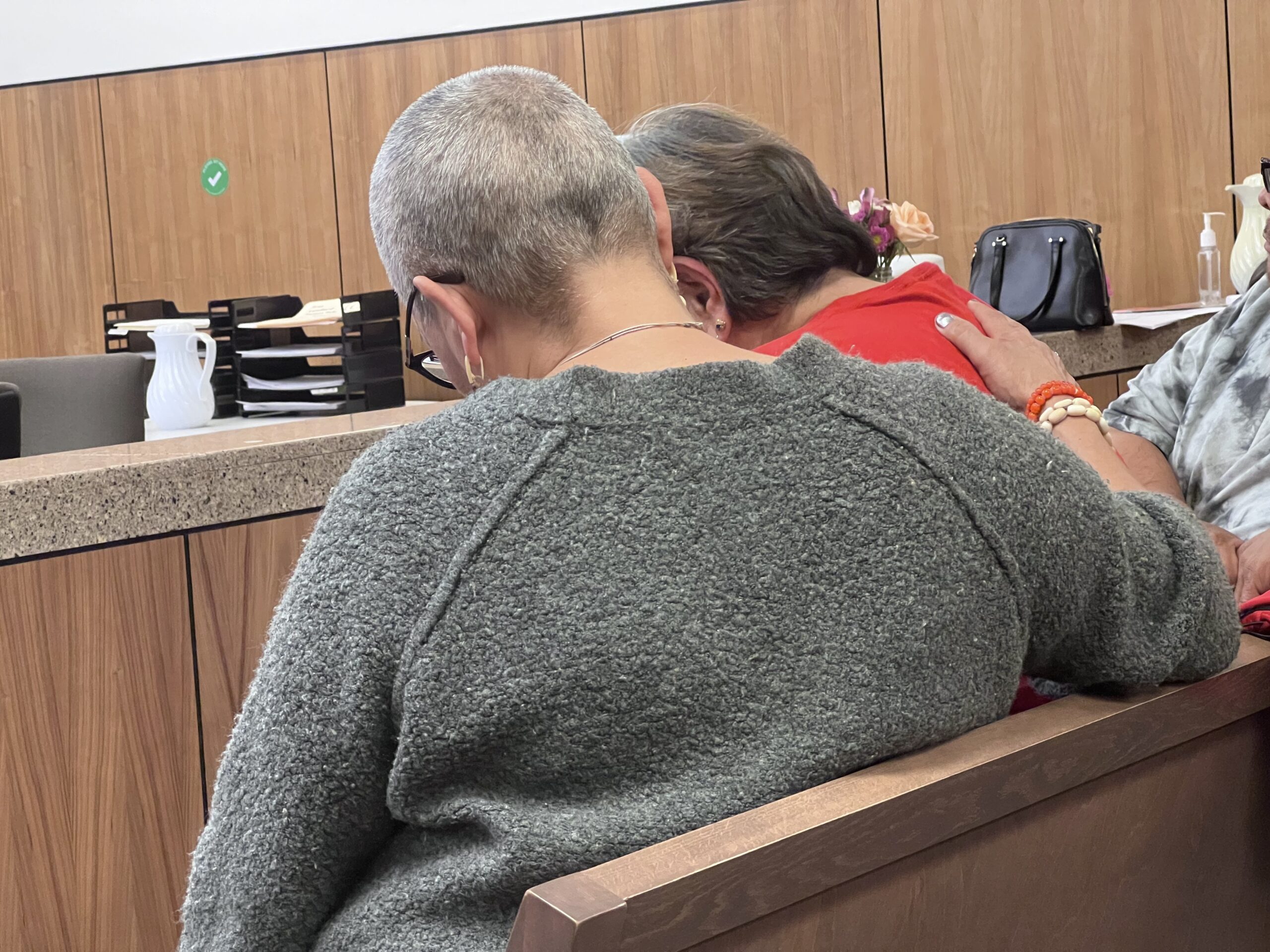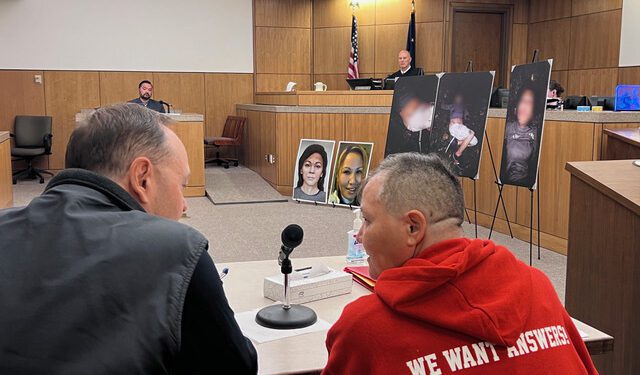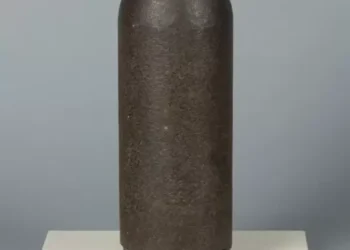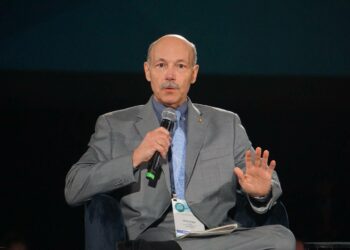Michael Livingston, an MMIP advocate and Marcella Boskofsky-Grounds prepare to question witnesses in the presumptive death hearing for Cassandra Boskofsky. (Rhonda McBride/KNBA)
Presumptive death hearings are common in Alaska. Hikers, hunters and boaters often go missing, never to be seen again.
But there are also those who disappear from the streets of Anchorage, like three Alaska Native women who crossed paths with serial killer Brian Smith.
In July, the South African immigrant was sentenced to 226 years in prison for murdering two of the women, Kathleen Jo Henry and Veronica Abouchuk.
Smith was never charged in the death of a third woman.
Prosecutors said they could neither confirm her identity, nor prove he killed her. But Cassandra Boskofsky’s family went to court on Tuesday to ask for a death certificate and set the record straight, as a jury determined that she was the victim of a homicide.
RELATED: In Anchorage protest, woman’s family says she is convicted killer Brian Smith’s third victim
Presumptive death hearings don’t usually pack a courtroom with TV cameras rolling. But this case involved Smith, convicted in what the national media dubbed the Memory Card Murders, because of the two killings he recorded on cellphones.
 Family and friends of Cassandra Boskofsky wore red to show their support. (Rhonda McBride/KNBA)
Family and friends of Cassandra Boskofsky wore red to show their support. (Rhonda McBride/KNBA)
The family wore red shirts with a photo of a young and happy Cassandra that said, “Where is Cassandra?” at the top — “Justice for Cassandra” at the bottom — and on the back, “We want answers.”
 Terrie Boskofsky shows the T-hirt the family made. The portrait of Cassanda Boskofsky was taken when she attended West High School. (Rhonda McBride/KNBA)
Terrie Boskofsky shows the T-hirt the family made. The portrait of Cassanda Boskofsky was taken when she attended West High School. (Rhonda McBride/KNBA)
Poster-sized photos were on display, images of a woman believed to be Cassandra that came from one of Smith’s cellphones — bloody, battered and lifeless.
RELATED: Alaska prosecutors release photos of possible third victim in sentencing for convicted killer Brian Smith
 Before and after the presumptive death hearing, posters appeared outside the Boney Courthouse. (Rhonda McBride/KNBA)
Before and after the presumptive death hearing, posters appeared outside the Boney Courthouse. (Rhonda McBride/KNBA)
When police confronted him about the pictures after his arrest in 2019, he told them she was alive, but had passed out on the ground from alcohol.
Nick Pestrikoff says he knew immediately that the woman was his cousin, Cassandra.
“I’ve known her since she was born. She didn’t have a stable home,” Pestrikoff said. “Her Dad liked his liquor, and so did her mother.”
Cassandra grew up in two Kodiak-area communities, Ouzinkie and Old Harbor. Pestrikoff says Cassandra had the same struggle as her parents.
“She did. She had it rough, but she still had the capacity to love,” he said. “She dearly loved me, and I dearly loved her.”
 Cassandra Boskofsky’s family brought fresh flowers to the courtroom in her honor. (Rhonda McBride/KNBA)
Cassandra Boskofsky’s family brought fresh flowers to the courtroom in her honor. (Rhonda McBride/KNBA)
Pestrikoff says it’s a love that’s hard to understand. But despite the chaos of life on the streets, that love, though painful, somehow endures. And it is out of that love, that the family petitioned the court to grant a death certificate – to end the limbo and bring peace to Cassandra.
“The presumptive death hearing is held when a person has disappeared,” Anchorage District Court Judge Brian Clark explained to the courtroom.
He said the hearing is like a trial, only there are no attorneys. Instead, the family must present evidence to a jury of six people, who have one question to answer.
“Has sufficient evidence been presented,” he said, “from which it fairly may be presumed that the missing person has met death?”
The jury can also question the witnesses and advise the court on the date and cause of the person’s death. The judge says the standard of proof is much lower than a criminal trial.
“If you find more than 50 percent that something is true,” Clark said, “it is in fact true under the law for this kind of a hearing.”
Truth is what the family hoped the trial would bring to light. They believe Anchorage police have not been entirely honest with them. But at the hearing, they have a chance to demand answers.
 Anchorage Police Department Detective Brendan Lee exits the courtroom. (Rhonda McBride/KNBA)
Anchorage Police Department Detective Brendan Lee exits the courtroom. (Rhonda McBride/KNBA)
Another of Cassandra’s cousins, Marcella Boskofsky-Grounds, called her first witness, the lead investigator into the Smith murder case, Detective Brendan Lee.
“Is that Brian Smith’s foot in the photographs?” she asked.
Lee said a search of Smith’s house turned up shoes that matched the one worn in the photo believed to be Cassandra.
“We believe that to be his foot in the photos. Yes,” Lee said.
The family says Smith’s foot beside her body fits a pattern of his killings, in which he stages the scene to later show off his handiwork.
 Brian Smith walks out of an Anchorage courtroom after receiving a 226-year prison sentence. Anchorage Superior Court Judge Kevin Saxby said Smith, who was convicted of killing two Alaska Native women, was beyond rehabilitation. (Matt Faubion/Alaska Public Media)
Brian Smith walks out of an Anchorage courtroom after receiving a 226-year prison sentence. Anchorage Superior Court Judge Kevin Saxby said Smith, who was convicted of killing two Alaska Native women, was beyond rehabilitation. (Matt Faubion/Alaska Public Media)
Lee said Smith had deleted three photos from his cell, but police technicians were able to recover the images in October 2019. Not long afterwards, APD shared them widely with other law enforcement officers and shelters. An Anchorage Safety Patrol officer told them the pictures looked like Cassandra Boskofsky, a 38-year-old woman they encountered on a regular basis. Over the years, she had racked up a string of alcohol-related offenses.
Lee contacted the family and asked if they had seen Cassandra. He told them she had gone quiet on the streets, but didn’t tell them about the photos. During the hearing the judge wanted to know exactly when the family saw the pictures.
Marcella Boskofsky said not until July 6 of this year — three days before Smith was to be sentenced and after prosecutors had released the photos, along with a composite sketch, in a sentencing memo. Boskofsky says police contacted her because they were afraid the media would publish the images and wanted to prepare the family.
Police then shared the photos with her over Facebook and later came to her home with a chaplain.
One of the lingering questions from the family: Why weren’t they shown the photos five years ago?
“To this day, at the Anchorage Police Department, we have not been able to 100 percent identify the female in the photos as Cassandra,” Lee said. “We have obviously been in contact with the family, who have looked at the photos and feel strongly and believe it was her. But at this time, we haven’t been able to 100 percent identify her.”
Lee says without remains and positive identification, there is always a chance of mistaken identity and the risk of putting a family through unnecessary grief.
“This story really is a microcosm of a bigger challenge that we have in Alaska,” said Michael Livingston, a retired police officer and a Missing and Murdered Indigenous People activist.
Livingston, who is Unangan, says APD’s treatment of Boskofsky’s family should raise a lot of questions for other MMIP families.
“How many other pictures (do) the Anchorage Police Department, or other law enforcement agencies in Alaska, have, who may in the pictures appear to be deceased,” he said. “And we’re wondering why it’s the policy of the Anchorage Police Department to not reach out to the families and say, ‘Could this possibly be your daughter?’”
In the case of Cassandra Boskofsky, the jury did provide some relief. The three-woman, three-man jury was unanimous in its decision that there was enough evidence to grant a death certificate.
 Alice Crow comforts Terrie Boskofsky after the jury’s decision to grant the family of Cassandra Boskofsky a death certificate. (Rhonda McBride/KNBA)
Alice Crow comforts Terrie Boskofsky after the jury’s decision to grant the family of Cassandra Boskofsky a death certificate. (Rhonda McBride/KNBA)
After the verdict, a wave of tears and anguish rolled over the room. But Cassandra’s aunt, Terrie Boskofsky, says she’s glad her family went through this process to bring closure. She believes it can help other families with missing loved ones.
“There are so many, so many family members that were taken and nobody knows where they’re at,” she said.
 After the jury announced it would award Cassandra Boskofsky’s family a death certificate, members broke out in tears. (Rhonda McBride/KNBA)
After the jury announced it would award Cassandra Boskofsky’s family a death certificate, members broke out in tears. (Rhonda McBride/KNBA)
Boskofsky says the last anyone had heard from her niece was on Sept. 18, 2019, when Cassandra reached out to wish her a happy birthday.
“Nobody heard from her since. Not one of us,” she said.
And while the word “missing” once left room for hope, Boskosfsky says, it has left the family in a state of paralysis. She says she’s grateful the jury also declared Cassandra’s death a homicide — and hopes it will encourage police to look for her remains, so the family can finally bring Cassandra home.
Source link : http://www.bing.com/news/apiclick.aspx?ref=FexRss&aid=&tid=66db9b3b93e34f8094cbc02e5da9fd8c&url=https%3A%2F%2Falaskapublic.org%2F2024%2F09%2F06%2Falaska-native-woman-believed-slain-by-serial-killer-brian-smith-declared-homicide-victim%2F&c=7301210537727933155&mkt=en-us
Author :
Publish date : 2024-09-06 09:51:00
Copyright for syndicated content belongs to the linked Source.







